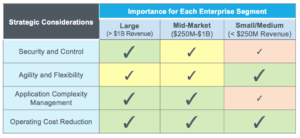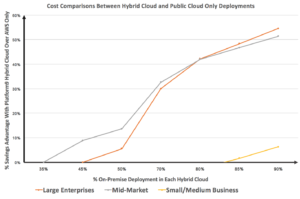Enterprise Hybrid Cloud: Strategy and Cost Considerations
A clearly defined cloud strategy is an imperative need during any enterprise’s transition to a cloud based IT environment. To minimize risks and make the right choice between private, public, and hybrid cloud options, it is important to devise an effective enterprise hybrid cloud strategy with the following considerations in mind:
- Security and Control
- Is it important to have physical access to the infrastructure and platforms that are used to provision workloads?
- Are there any security and compliance requirements that need to be met for customers?
- Agility and Flexibility
- Which cloud choice will adequately meet resource demands for developer and business needs?
- Which cloud environment will adequately support customers during high demand/peak usage times?
- Application Complexity Management
- Does the IT environment need to support legacy, virtualized, microservices-based, and serverless applications?
- Operating Cost Reduction
- What will be the costs of deploying, managing and maintaining IT infrastructure be with each cloud choice?
Cloud Strategy Definition: Mapping Strategic Considerations to Market Segments
The following chart depicts the importance of these four criteria across large, mid-market, and SMB segments as observed by Platform9:

The importance of each of these strategic considerations can be understood as follows:
- In large organizations, security and control, application complexity management, and operating cost reduction are typically non-negotiable. Agility and flexibility might have lesser importance in comparison with the other considerations.
- For the mid-market segment, application complexity management and operating cost reduction are more important than the other two factors.
- For the SMB segment, agility and flexibility, as well as operating cost reduction, are usually much higher priorities than the other two considerations. These organizations are willing to make tradeoffs for security and control and application complexity management.
Cloud Strategy Definition: Mapping Strategic Considerations to Cloud Options
Let us now discuss how these four factors can influence cloud strategy and choice.
Security and Control: Private clouds are considered more secure than public clouds for these two reasons:
- Data stored in a public cloud is placed on the cloud provider’s storage and within its data centers. It is not possible to ascertain who amongst the provider’s numerous employees and contractors have access to your data and whether the data has been accessed by any of those individuals.
- Private clouds offer more controls and customizations over security configurations. With a public cloud provider, you are restricted to a limited set of security tools offered.
Agility and Flexibility: A public cloud provides greater agility and flexibility in comparison to a private cloud. Public clouds, such as Amazon Web Services and Google Cloud Platform, offer massive amounts of capacity and deployments can be architected to better handle dramatic demand spikes. As a result, it can be easier to meet requirements of developers and customers.
Application Complexity Management: Public clouds offer a wide selection of operating systems, virtual machines, microservices, and serverless technologies, and the tools to manage and monitor these types of applications. With a private cloud, you will invest more time and resources for management of newer application paradigms, such as microservices and serverless applications, since existing tools will not offer these management capabilities.
Operating Cost Reduction: Each of the three major public cloud vendors tries to closely match on price, and charge only for resources consumed (utility-style pricing). In addition, it is no longer necessary to have an IT team for deploying, maintaining, and upgrading on-premises hardware, hypervisors and operating systems. However, as experienced by several Platform9 customers, public costs can skyrocket due to large volume data transfers and unmonitored resources.
It is clear that neither a private cloud or public only approach can address the strategic considerations by themselves. Having a private or public cloud only approach requires enterprises to make tradeoffs.
The importance of a hybrid cloud arises in such situations. A hybrid cloud allows you to harness select benefits from both the public and private cloud pathways while balancing the trade-offs.
Designing the Enterprise Hybrid Cloud: How Should Workloads be Distributed Between Private and Public Clouds
A hybrid cloud can be architected to include a significant proportion of workloads on either the public cloud or the private cloud. In order to intelligently implement an enterprise hybrid cloud, it is important to decide what proportion of an enterprise’s workloads will reside on-premises and in the public cloud. The ideal mix of public and on-premises workloads can be determined by considering both cost factors and the type of workload.
Determining Hybrid Cloud Workload Locations Based on Costs
In general, adopting an enterprise hybrid cloud strategy with a combination of proprietary software based private clouds and public cloud(s) will be more expensive than adopting a public cloud only strategy. However, operating a Platform9 SaaS-Managed open source based hybrid cloud solution can provide significant cost savings over a public cloud only strategy. The cost savings achievable in such cases will vary based on the enterprise size (which largely aligns to IT complexity) and the workload distribution between private/public cloud locations.
The following chart shows the cost advantage enterprises can achieve through an enterprise hybrid cloud strategy enabled by Platform9 over a public cloud only (i.e. 100% of workloads on a public cloud e.g. AWS).

As can be seen from the chart, for all enterprise segments, as more workloads are located on-prem (and correspondingly, fewer workloads reside in the public cloud), the cost savings of a hybrid cloud approach are superior relative to a public cloud only option.
Large and mid-market enterprises can achieve higher cost savings over a public cloud only approach by locating a very large proportion (> 80%) their workloads on-premises. For example, with 90% of workloads on-premises and 10% on AWS, cost savings for large enterprises is 55% , 51% for mid-market enterprises but only 6% for SMBs. The study shows, for large enterprises, if < 45% of workloads are on-premises then there is no economic gain over running all workloads on AWS. With such a workload distribution approach, it might make more sense to consider a 100% public cloud approach. More workloads have to be located on-premises to realize cost savings if a hybrid cloud approach is desired. A similar situation is observed for mid-market enterprises with < 35% of workloads on premises.
The study also indicates that for smaller enterprises with lower IT complexity and smaller number of workloads, a public cloud only approach might be more suitable than a hybrid cloud.
Determining Hybrid Cloud Workload Locations Based on Criticality to Enterprise
Workloads can also be classified as mission-critical or business-critical to arrive at the right on-premises and public cloud mix. Mission critical workloads are those that are essential to run your business: product/service delivery to your customer, financial transactions for products/services offered, manufacturing, and so on. Mission-critical applications should typically be deployed on-premises to allow the IT team to proactively monitor the entire application and infrastructure stack, and respond to application and system events on a 24×7 schedule. On-premises deployment for mission-critical workloads will also provide more control over security configurations.
Business-critical workloads are those that are amenable to some downtime. Examples include email services provided by Office 365, business intelligence workloads, etc. Using the public cloud for these workloads can reduce operational expenditure without creating substantial risk for the company. Such a strategy also allows the in-house IT team to focus on “keeping the lights on” with mission-critical workloads.
Takeaways
In order to make a strategic choice between public, private and hybrid cloud options, four factors must be considered: security and control, agility and flexibility, application complexity management, and operating cost reduction.
Among the three cloud models, an enterprise hybrid cloud melds public and private cloud benefits and balances trade-offs. As a result, a hybrid cloud approach has increasingly become the preferred option for enterprises. Platform9 has observed this first hand with many of its customers who start thinking about a private or public cloud only approach and then shift to a hybrid cloud strategy. Intelligent design of workload distributions in a hybrid cloud needs to be made by taking into account both the cost savings achievable and the type of workload.
Thanks for taking the time to read this blog. Are you currently thinking about how to establish your organization’s cloud strategy? Are you developing a plan to determine your workload distributions across private and public cloud deployments?
- Beyond Kubernetes Operations: Discover Platform9’s Always-On Assurance™ - November 29, 2023
- Platform9 Introduces Elastic Machine Pool (EMP) at KubeCon 2023 to Optimize Costs on AWS EKS - November 15, 2023
- KubeCon 2023 Through Platform9’s Lens: Key Takeaways and Innovative Demos - November 14, 2023